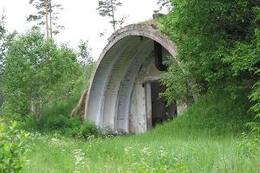Smilkalų ir Rohu raketų bazė
Rakverės mieste, Arknos plente, septintajame ir aštuntajame dešimtmečiuose buvo įsikūręs 304-asis sovietų gvardijos raketinis pulkas (s/o 14372), kuris turėjo dvi divizijas – vieną Kadiloje, kitą – Rohu-Lebavere miškuose. Šioje bazėje buvo padalinys, aptarnaujantis raketas R-12, kurios Tarybų Sąjungoje buvo pradėtos eksploatuoti 1959 m. Šios raketos galėjo nuskristi 2 tūkst. kilometrų, gabendamos 1 arba 2,3 megatonos (1 mgt = 1 mln. tonų) termobranduolines galvutes. Teritorija, kurioje buvo padalinys, buvo aptverta dviguba spygliuota tvora. Tarp dviejų tvorų buvo vielos tinklas, prijungtas prie aukštos įtampos elektros. Žmogui ar gyvūnui palietus tvorą, suveikė signalinė sistema, nurodanti sąlyčio tašką. Vartuose stovėjo kulkosvaidžių lizdai. Miškuose išsidėstę raketų daliniai buvo vadinami artilerijos divizijomis. Žmonės nežinojo, kad aplinkui miškuose yra branduolinių raketų. Divizijos teritorijoje buvo skirtingos zonos. Pirmojoje zonoje buvo sargybos įgulos ir pareigūnų darbo patalpos, štabas, amunicijos sandėliai, požeminės kuro talpyklos, mašinų garažai. Karininkai gyveno Rakverės karinėje apygardoje. Antroje zonoje buvo karių kareivinės, pirtis, skalbykla, valgykla, klubas, katilinė, elektrinė. Ūkiniame kieme buvo maisto sandėliai, garažai su technika, mazuto saugykla. Mūšio zona – svarbiausia bazėje. Tai savo ruožtu buvo atskirta nuo kitų zonų. Kovos zonoje buvo specialiojo raketų kuro saugykla, surinkimo aikštelė, angarai raketoms ir jų aptarnavimui, paleidimo aikštelės. Viena divizija turėjo 4 raketų angarus. Buvo vienas angaras ir viena paleidimo aikštelė dviem raketoms. Prireikus iš karto buvo galima paleisti 6 raketas, 2 buvo rezerve. Raketos stovėjo horizontalioje padėtyje ant ratuotų stovų angare. Raketos ilgis, įskaitant kovinę galvutę, buvo 22,1 m. Tiek vasarą, tiek žiemą saugykloje turėjo būti pastovi temperatūra (+4ºC) ir drėgmė. Naudojama automatinė vėdinimo sistema, užtikrinanti stabilų mikroklimatą. Iš angaro katilinės vamzdžiais atėjo šiltas oras. Abi čia esančios miškuose esančios bazės dalys buvo vienodos. Tik Rohusas (Lebaveres) buvo abiejų divizijų branduolinių galvučių saugykla, šaudymo poligonas ir kiaulidė. Netoli Kadilos padalinio esantys lokatoriai aptarnavo ir Kadilos, ir Rohu bazes. Iš bazės įrenginių išlikę griuvėsiai. Kai bazė buvo tuščia, esamus pastatus kaip statybines medžiagas naudojo ir kolūkiai, ir privatūs asmenys. Rohu bazės teritorijoje yra beveik 5 angarai: 2 branduoliniams užtaisams laikyti, 2 raketoms ir angaras jų aptarnavimui. Pastarojo sienoje tebėra „paveikslas“ su Lenino atvaizdu. Nuo pirmojo raketų angarų kelias veda į paleidimo aikštelę. Ant tvirto betoninio pagrindo dar visai neseniai, prieš metalo vagių grobstymą, gerai matėsi žiedas, prie kurio buvo pritvirtinta paleisti besiruošianti raketa. Viename iš sandėliavimo angarų matyti masyvi branduolinės saugyklos durų stakta (taip pat apiplėšta), prie kurios kadaise buvo pritvirtintos iki pusės metro storio durys. Kadilos bazėje yra beveik nepažeisti specialūs kuro sandėliavimo angarai ir raketų angaras bazės gale, iš kurio kelias veda į paleidimo aikštelę. Ant tvirto betoninio pagrindo buvo ratas, kaip ir Rohu bazėje. Iš tolo matyti paleidimo aikštelę supantys pylimai, o paleidimo metu vis dar yra šešėlinė vieta, kur raketa buvo paslėpta. Netoliese „nepažeistas“ ir serviso angaras. Čia esančių raketų aptarnavimas buvo sudėtingas ir sudėtingas. Per dešimtmetį bazė morališkai paseno. Minėtas karinis dalinys buvo likviduotas 1978 m. antroje pusėje. Naujoms mobilioms raketų sistemoms buvo pastatytos požeminės šachtos ir pažangesni paleidimo įrenginiai. Naujo tipo (R-12U) raketos buvo daug greičiau aptarnaujamos ir sunkiau aptinkamos.
Susijusi laiko juosta
Susijusios vietos
Kadilos ir Rohu raketų bazės
This missile base is situated around 10 km from the small borough of Väike-Maarja.
It formed part of the nuclear missile base established in Rakvere during the Soviet era. The base was operated from Rakvere during the 1960s and 1970s. It was closed in 1978, having been depreciated.
What remains today is mostly in ruins. Some of the missile, maintenance and storage hangars and landing fields are still intact.





